|
|
Interface Design of Iron Nanoparticles for Environmental Remediation
SU Li, YANG Jianping, LAN Yue, WANG Lianjun, JIANG Wan
2021 Vol. 36 (6): 561–569
 Abstract
Abstract(
775 )
 HTML
HTML(
84)
 PDF
PDF(9247KB)(
1125
)
Recently, iron nanoparticles have become one of the main research materials for environmental remediation due to the excellent catalytic/reduction performance, low cost and environmental friendliness. At present, the research of iron nanoparticles mainly focuses on the heavy metal removal, organic pollution degradation, inorganic anion catalytic reduction in sewage system, etc. However, there still exist some problems, such as low removal efficiency, poor stability, and single removal on account of several self-defects of agglomeration and tedious structures. Hence, this review focuses on the following aspects: 1) controllable preparation of iron nanoparticles; 2) interface design of iron composites; 3) application of iron nanoparticles in heavy metals removal and electrocatalytic denitrification; 4) prospect of iron nanoparticles composites in environmental remediation.
|
|
|
Texturing Technology on Multicrystalline Silicon Wafer by Metal-catalyzed Chemical Etching: a Review
WU Xiaowei, LI Jiayan
2021 Vol. 36 (6): 570–578
 Abstract
Abstract(
626 )
 HTML
HTML(
26)
 PDF
PDF(3869KB)(
1041
)
In the production process of multicrystalline silicon solar cells, diamond wire sawn (DWS) cutting technology attracts wide attention because of its advantages of high cutting speed, high precision and less loss of raw materials. But the traditional acid etching technology cannot match the shallow damage layer formed on the surface of diamond wire sawn cut multicrystalline silicon wafer to make the texture surface. On the contrary, the metal-catalyzed chemical etching method owns the advantages of simple operation, controllable structure and easy to form the structure with high aspect ratio, indicating a wide range of application on diamond wire sawn cut multicrystalline silicon wafer. This paper systematically summarizes the work of the etching mechanisms and the structures of textures by different metal catalysts in the process of making texture surface, and deeply discusses the single and composite catalytic etching process of Ag and Cu, the structure of texture surface, and the performance of solar cells. Finally, the problems of metal-catalyzed chemical etching on the surface of diamond wire sawn cut multicrystalline silicon are analyzed, and their future research directions are prospected.
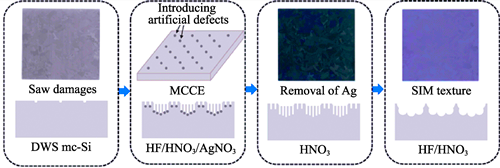
|
|
|
Synthesis and Gas Separation of Chabazite Zeolite Membranes
LI Ziyi, ZHANG Jiajia, ZOU Xiaoqin, ZUO Jiayu, LI Jun, LIU Yingshu, PUI David Youhong
2021 Vol. 36 (6): 579–591
 Abstract
Abstract(
1144 )
 HTML
HTML(
65)
 PDF
PDF(4119KB)(
1337
)
Chabazite (CHA) zeolite membranes exhibit superior performances in light gas separations owing to the eight-membered ring channel structure with small pore size (0.38 nm), adjustable surface characteristics, and high material stability and preparation reproducibility, and have gradually become one of the hot spots of zeolite membrane research in recent years. This review article first introduces the basic characteristics, the two typical CHA zeolite membranes (SAPO-34 and SSZ-13 membranes), then compares the synthesis and preparation methods of CHA zeolite membranes (in-situ synthesis, secondary growth synthesis, microwave heating methods) and analyzes their advantages and disadvantages in application status. The influences of their key synthesis conditions of the secondary growth as the mainstream synthesis method on the qualities of SSZ-13 and SAPO-34 membranes have been elaborated in detail, mainly including 1) the seeding conditions, such as carrier type, seeding crystal and seeding approach; 2) the hydrothermal synthesis conditions, such as crystallization time and temperature, water content, silica-to-alumina ratio, structure directing agent, and cation type; 3) the calcination approaches, such as conventional calcination, staged calcination, and rapid heating treatments. After comparative analysis, the preferred synthesis of the above two typical CHA zeolite membranes are proposed. Furthermore, the modulation of membrane surface chemistry is discussed for the enhancement in gas separation, such as silica-to-alumina ratio adjustment, ion exchange, heteroatom substitution, amino-group functionalization, and surface modification. The detailed characteristics of gas separation in various gas mixture systems and the permeation properties of different single gases on CHA zeolite membranes are analyzed and summarized as well. Finally, the future development of CHA zeolite membranes is prospected.
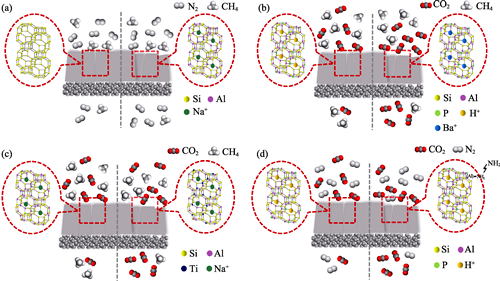
|
|
|
Research Progress in Polymer-based Metal-organic Framework Nanofibrous Membranes Based on Electrospinning
LI Tingting, ZHANG Zhiming, HAN Zhengbo
2021 Vol. 36 (6): 592–600
 Abstract
Abstract(
1380 )
 HTML
HTML(
73)
 PDF
PDF(6351KB)(
1942
)
Metal organic frameworks(MOFs) nanofibrous membranes (NFMs) based on electrospinning technology integrate the advantages of inorganic porous materials and polymer nanofibers, enabling them a class of functional materials with broad application prospects. MOFs NFMs with different functions are explored continuously and their application fields are expanding. In this work, we briefly introduce the development of MOFs NFMs, which has experienced a gradual transformation from preparation research to application research. Then, the main methods on preparing MOFs NFMs, including mixed electrospinning, in situ growth, multistep seeded growth, and atomic layer deposition, are described in detail. The main application and of current MOFs NFMs, such as adsorption and separation, heterogeneous catalysis, sensing detection are expounded. And, we put forward the future prospect of the development directions and trends of MOFs NFMs.
|
|
|
3D Printing and Characterization of Microsphere Hydroxyapatite Scaffolds
WU Zhongcao, HUAN Zhiguang, ZHU Yufang, WU Chengtie
2021 Vol. 36 (6): 601–607
 Abstract
Abstract(
794 )
 HTML
HTML(
37)
 PDF
PDF(9075KB)(
1178
)
Surface microstructure of biomaterials plays an important role in osteogenesis. In this study, we prepared a series of hydroxyapatite (HA) scaffolds (HA0, HA10, HA30, HA50) by 3D printing microspheres with different particle sizes (<60 μm). These scaffolds have similar physical and chemical properties, but form different microstructures due to their different particle size of microspheres, which result in certain impact on their biological properties. Compared with the traditional scaffolds without micro-sphere structure (HA0), the microsphere-based hydroxyapatite scaffolds provide improved adhesion and growth sites for bone mesenchymal stem cells (BMSCs) after 24 h culture, among which HA30 scaffold significantly promotes the pseudopodia elongation of BMSCs. After 5 d of cell culture on the scaffolds, the micro-sphere based HA scaffolds significantly stimulate proliferation of the BMSCs in contrast to the HA0 group. HA30 scaffolds with microsphere at similar size to the cell size have the best promoting effect on cell proliferation. Therefore, 3D printing technology can not only control the macrostructure of HA scaffolds, but also construct the microstructure on the surface of HA scaffolds by controlling the particle sizes of bioceramic powders to optimize the biological effects, which shows great potential application in the field of bone tissue engineering.
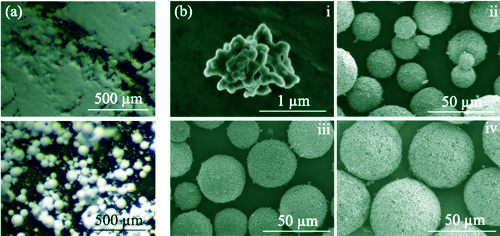
|
|
|
Preparation of Silicon Nanowires and Porous Silicon Composite Structure by Electrocatalytic Metal Assisted Chemical Etching
CHEN Lichi, WANG Yaogong, WANG Wenjiang, MA Xiaoqin, YANG Jingyuan, ZHANG Xiaoning
2021 Vol. 36 (6): 608–614
 Abstract
Abstract(
484 )
 HTML
HTML(
19)
 PDF
PDF(15458KB)(
839
)
The quantum confinement effect brings good field emission characteristics to silicon nanowires, which is expected to improve the performance of field emission device through combination with the quasiballistic electrons drift model in porous silicon structure, but the efficiency of traditional metal assisted chemical etching is low. Constant current source was introduced on the basis of traditional metal assisted chemical etching in the present work, and a electrocatalytic metal assisted chemical etching method was proposed to achieve high-efficiency preparation of silicon nanowires and porous silicon composite structure. The preparation rate of silicon nanowires is 308 nm/min at 30 mA current, which is increased by 173% compared with that adopted the traditional method. Moreover, the effects of AgNO3 concentration, etching time and etching current on the morphology of the composite structure were investigated. The field emission characteristics of the structure prepared by electrocatalytic metal assisted chemical etching were tested. The current density is 64 μA/cm2 under the electric field of 14.16 V/μm, and threshold electric field is 10.83 V/μm.
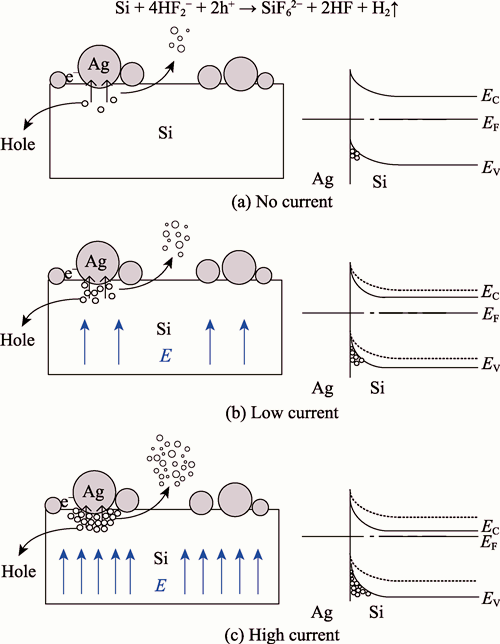
|
|
|
Fe(III)/rGO/Bi2MoO6 Composite Photocatalyst Preparation and Phenol Degradation by Photocatalytic Fenton Synergy
AN Weijia, LI Jing, WANG Shuyao, HU Jinshan, LIN Zaiyuan, CUI Wenquan, LIU Li, XIE Jun, LIANG Yinghua
2021 Vol. 36 (6): 615–622
 Abstract
Abstract(
798 )
 HTML
HTML(
27)
 PDF
PDF(1728KB)(
1223
)
The photocatalysis-Fenton technology coupling can efficiently degrade organic pollutants. In this study, Fe(III)-doped rGO/Bi2MoO6 composite catalyst (Fe(III)/rGO/Bi2MoO6) was prepared by solvothermal method, and the photocatalysis-Fenton synergy system was constructed by adding H2O2. The phenol degradation activity under 3 h visible light irradation is 82%, much higher than that of photocatalysis alone (18%) or renton reaction (48%), and further optimization can achieve full degration of phenol. This can be mainly attributed to the transformation of the valence state through the gain and loss of Fe electrons, which serves as a bridge to realize the photocatalysis- Fenton synergy. Meanwhile, the excellent electrical conductivity of graphene overcomes the difficulty of separating photo-generated electron holes in photocatalysis, and promotes the cyclic reaction of Fe3+/Fe2+, and then accelerates the Fenton reaction to produce more free hydroxyl groups (?OH), which further improves the degradation efficiency. Effects of Fe(III) content, catalyst dosage, H2O2 content, and pH on the synergy degradation performance were investigated. The quenching experiment proves that ?OH is one of the main active species in the degradation system, while ?O2- and H+ also have a certain effect on the degradation activity. The mechanism of Fe(III)/rGO/Bi2MoO6 photocatalysis-Fenton synergy degradation is also proposed based on the present experimental results.
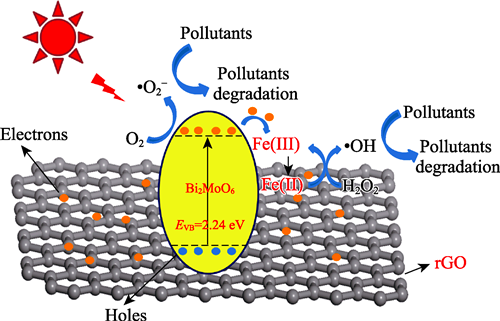
|
|
|
Electrochemical Activity of Positive Electrode Material of P2-Nax[Mg0.33Mn0.67]O2 Sodium Ion Battery
ZHANG Xiaojun, LI Jiale, QIU Wujie, YANG Miaosen, LIU Jianjun
2021 Vol. 36 (6): 623–628
 Abstract
Abstract(
837 )
 HTML
HTML(
47)
 PDF
PDF(3195KB)(
1167
)
With the advantages of low cost and wide distribution of raw materials, sodium-ion batteries are considered to be the best alternative materials for lithium-ion battery cathode materials. In the P2-phase NaMnO2 with layered structure, binary solid solution of the transition metal layer can effectively improve the electrochemical performance of the electrode material. In this study, the structural model of Nax[Mg0.33Mn0.67]O2 with Mg ion solid solution was constructed by using the Coulombic model. The first-principles calculations revealed that discharge voltage of Nax[Mg0.33Mn0.67]O2 reached 3.0 V at a sodium ion content of less than 0.67. Electronic density of states and charge population analysis showed that the solid solution of Mg motivated the anionic electrochemical activity of lattice oxygen in the P2-phase Nax[Mg0.33Mn0.67]O2, which transformed the electrochemical reaction mechanism of the system from cationic and anionic synergic redox reaction to reversible anionic redox reaction. This transformation provides a novel method for the design of electrode materials for Na ion batteries, as well as a new approach for the optimization and exploration of other ion batteries.
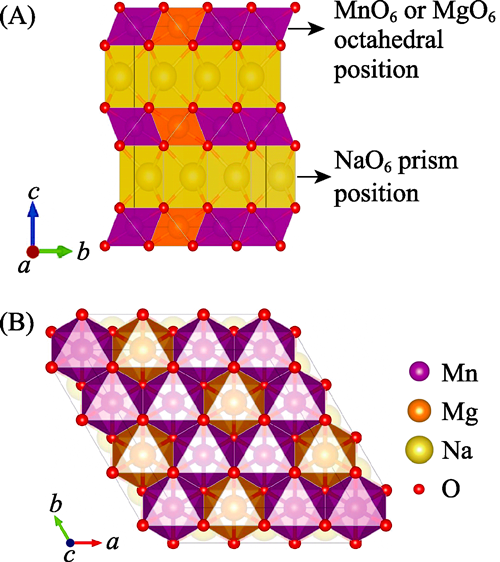
|
|
|
Passiviation of L-3-(4-Pyridyl)-alanine on Interfacial Defects of Perovskite Solar Cell
LIU Wenwen, HU Zhilei, WANG Li, CAO Mengsha, ZHANG Jing, ZHANG Jing, ZHANG Shuai, YUAN Ningyi, DING Jianning
2021 Vol. 36 (6): 629–636
 Abstract
Abstract(
700 )
 HTML
HTML(
42)
 PDF
PDF(2298KB)(
873
)
In recent years, perovskite materials become a research hotspot in the field of solar cells due to their excellent photovoltaic properties, but control of their interface defects still remains one of the key problems to be solved. In this study, an organic small molecule additive (L-3-(4-pyridyl)-alanine (PLA)) was introduced in the preparation of perovskite photoabsorption layer by two-step solution method. The characterizations showed that the introduction of PLA could comprehensively improve photoelectric performance of the device, with optimal energy conversion efficiency of 21.53%, in contrast to that of the reference device (20.10%). Further studies showed that PLA could reduce the trap state density of the device from 5.59×1016cm-3 to 3.40×1016cm-3, promote the interface charge extraction, and decrease the carrier recombination. The above improvements can be attributed to the PLA induced PbI2 enrichment at grain boundaries and PLA anchoring at defects, which play an important roles in passivate defects. This study can provide guideline for further regulating the defects of perovskite solar cells.
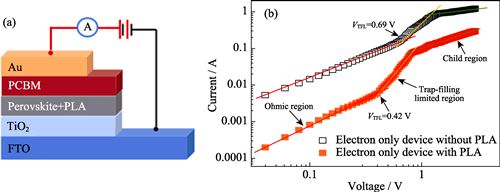
|
|
|
Amorphous Nd-Ni-B/NF Rare Earth Composites: Preparation and HER Electrocatalytic Performance
ZHU Yunna, CHEN Biqing, CHENG Tianshu, DU Chan, ZHANG Shimin, ZHAO Jing
2021 Vol. 36 (6): 637–644
 Abstract
Abstract(
599 )
 HTML
HTML(
19)
 PDF
PDF(7384KB)(
820
)
The amorphous nano-Nd-Ni-B rare earth (RE) alloy catalytic electrode on nickel foam (NF) was prepared by simple one-step electroless deposition method and served as a highly active hydrogen evolution reaction (HER) catalyst. Its microstructure and electrocatalytic HER performance were characterized. The results show that addition of Nd improved the electrocatalytic HER. The preparation conditions were optimized with neodymium nitrate of 3 g?L-1, reaction temperature of 35 ℃ and reaction time of 1 h. The Nd-Ni-B/NF electrode requires an overpotential of only 180 mV to achieve the current density of 20 mA?cm-2 in 1.0 mol?L-1 KOH solution, and the corresponding Tafel slope is 117 mV?dec-1. HER of Nd-Ni-B/NF catalyst is controlled by Volmer-Heyrovsky step. Moreover, the Nd-Ni-B/Nf shows superior electrochemical stability, 12 h chronoamperometry and 2000 sweeps of cyclic voltammetry with no obvious activity decay.
|
|
|
Anisotropic Calculation of Mechanical Property of GaAs Crystal
DONG Kangjia, JIANG Chen, REN Shaobin, LANG Xiaohu, GAO Rui, YE Hui
2021 Vol. 36 (6): 645–651
 Abstract
Abstract(
1251 )
 HTML
HTML(
33)
 PDF
PDF(1569KB)(
1016
)
Gallium arsenide possesses excellent photoelectric property which have been widely used in electron and semiconductor industries. To promote the cleavage manufacturing technology of gallium arsenide, the anisotropy of mechanical property of gallium arsenide is calculated in this work. The structural parameters, such as angle between the crystal planes, the spacing between planes and density of atoms, were calculated. The change rule of elastic modulus, Poisson’s ratio, shear modulus, hardness and fracture toughness of monocrystalline gallium arsenide on crystal {100} plane with crystal orientation was analyzed by generalized Hooke’s law and indentation tests. The results show that difference of structural parameters between planes is the main reason for the anisotropy of mechanical properties of GaAs. With variation of crystal orientation, the elastic modulus and Poisson’s ratio on the {100} crystal plane appear periodic changes, while shear modulus is identically equal to 59.4 GPa. Anisotropy of GaAs {100} crystal plane hardness changes slightly while fracture toughness changes greatly with a minimum value of 0.304 MPa·m1/2 in <110> crystal direction which is sensitive to the crack propagation.
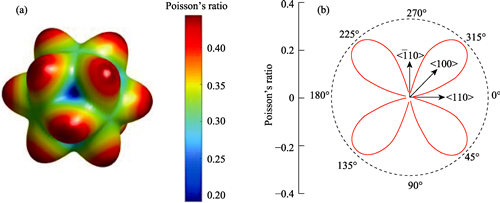
|
|
|
Directionally Solidified Al2O3/Er3Al5O12 and Al2O3/Yb3Al5O12 Eutectic Ceramics Prepared by Optical Floating Zone Melting
SUN Luchao, ZHOU Cui, DU Tiefeng, WU Zhen, LEI Yiming, LI Jialin, SU Haijun, WANG Jingyang
2021 Vol. 36 (6): 652–658
 Abstract
Abstract(
457 )
 HTML
HTML(
17)
 PDF
PDF(1530KB)(
908
)
Al2O3/Er3Al5O12(ErAG) and Al2O3/Yb3Al5O12(YbAG) eutectic rods with fine and homogeneous microstructure, free from cracks or pores, were directionally solidified using optical floating zone method at growth rate of 10 mm/h. The crystallographic orientation, preferred orientation, and 3D distribution of Al2O3 and Er3Al5O12/Yb3Al5O12 phases in the terminal growth zone of Al2O3/ErAG and Al2O3/YbAG eutectics were investigated by EBSD and high-resolution X-ray microscope. Vickers hardness of the as-prepared Al2O3/ErAG and Al2O3/YbAG eutectics are determined as (13.5±0.4) and (12.8±0.1) GPa, respectively. The fracture toughness results of Al2O3/ErAG and Al2O3/YbAG are (3.0±0.2) and (3.2±0.1) MPa·m1/2, respectively.
|
|
|
Effect of Different Alkali-assisted Deposition Precipitation Methods on the Durability of Three-way Catalysts
FAN Jun, JIANG Xue, JIAO Yi, CHEN Yusheng, WANG Jianli, CHEN Yaoqiang
2021 Vol. 36 (6): 659–664
 Abstract
Abstract(
433 )
 HTML
HTML(
12)
 PDF
PDF(651KB)(
937
)
The aging treatment always brings about severe deactivation of three-way catalysts (TWCs) so that improving the durability is one goal of TWCs design. In this work, Pt/Ce0.4Zr0.5La0.05Pr0.05O2 (Pt/CZ) TWCs were prepared by two different alkali-assisted deposition precipitation method, urea or ammonia. The effects of different alkali-assisted on the physicochemical properties, catalytic activity and durability were analyzed. It was found that the Pt/CZ catalyst prepared by urea-assisted deposition precipitation method (UDP) had poor aging resistance but the Pt/CZ catalyst prepared by ammonia-assisted (ADP) showed better anti-aging ability. Based on the results of XRD, CO adsorption, XPS and H2-TPR, comparatively larger particle size of Pt species and stronger interaction for ADP make it more difficult to sinter together during the aging treatment, which is favorable for maintaining catalytic activity. Therefore, the ADP catalyst shows a bright future for industrialization.
|
|
|
CuS Nanosheet Decorated Bi5O7I Composite for the Enhanced Photocatalytic Reduction Activity of Aqueous Cr(VI)
CAI Miao, CHEN Zihang, ZENG Shi, DU Jianghui, XIONG Juan
2021 Vol. 36 (6): 665–672
 Abstract
Abstract(
654 )
 HTML
HTML(
34)
 PDF
PDF(2202KB)(
1213
)
Photocatalytic approach has been extensively explored to remove toxic Cr(VI) in wastewater owing to its high efficient, safe and low cost features. Fabricating semiconductor composite is supposed to be an effective approach to improve the poor photocatalytic activity of single component. In this work, we prepared CuS nanosheets decorated Bi5O7I composites by a simple hydrothermal method, and characterized and evaluated its photoatalytic reduction activity of Cr(VI) under the visible-light irradiation. Compared to pure Bi5O7I microrods and CuS nanoparticles, the as-prepared CuS/Bi5O7I composites exhibits more efficient photocatalytic reduction of aqueous Cr(VI). The reaction rate constant of 15wt% CuS/Bi5O7I catalyst was 20 times and 4.3 times of that of pristine Bi5O7I and CuS, respectively. BET, photoluminescence and EIS spectra measurement demonstrate that the improved photocatalytic activity may be attributed to their higher surface areas, broader light absorption region, improved separation, and transfer efficiency of photo-induced electron-hole pairs. Moreover, a possible photocatalytic mechanism of CuS/Bi5O7I catalyst is also proposed.
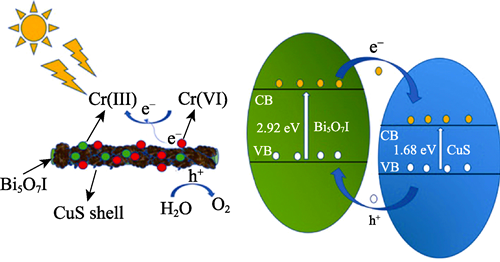
|
|